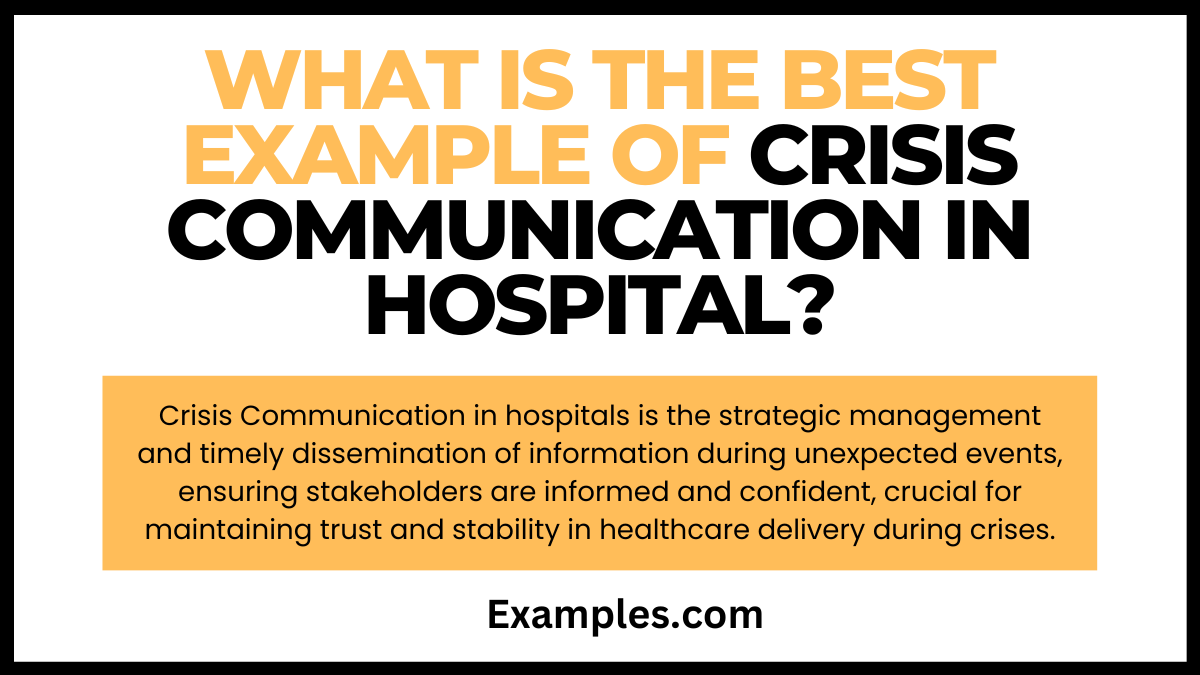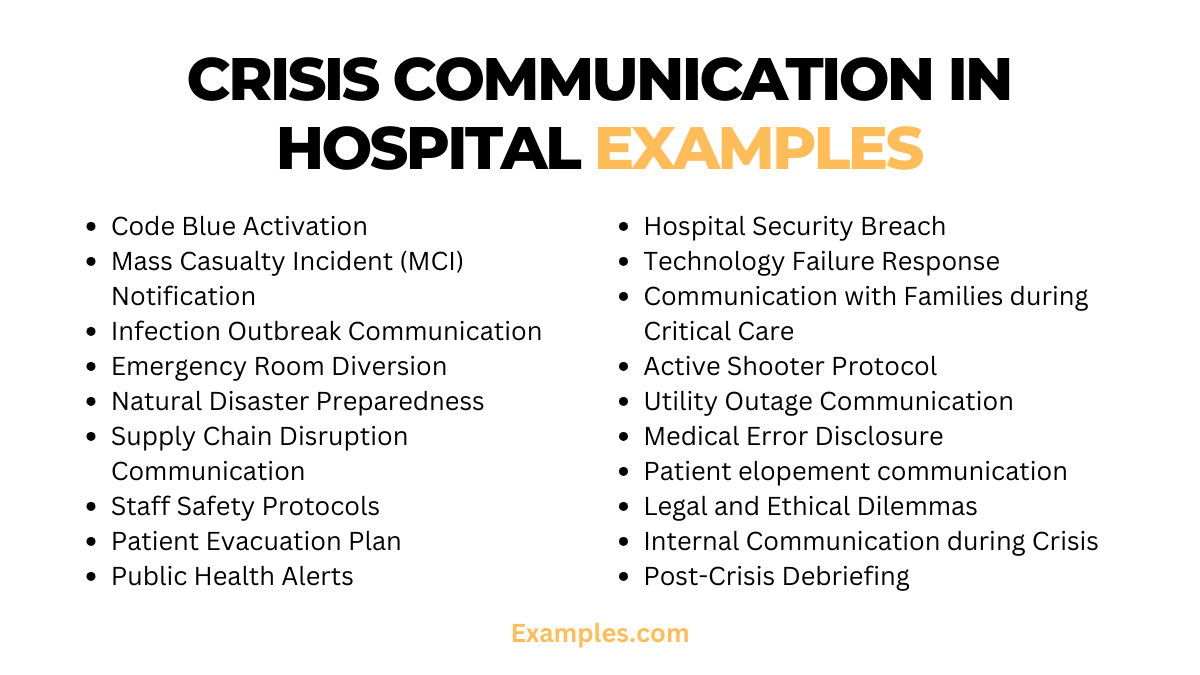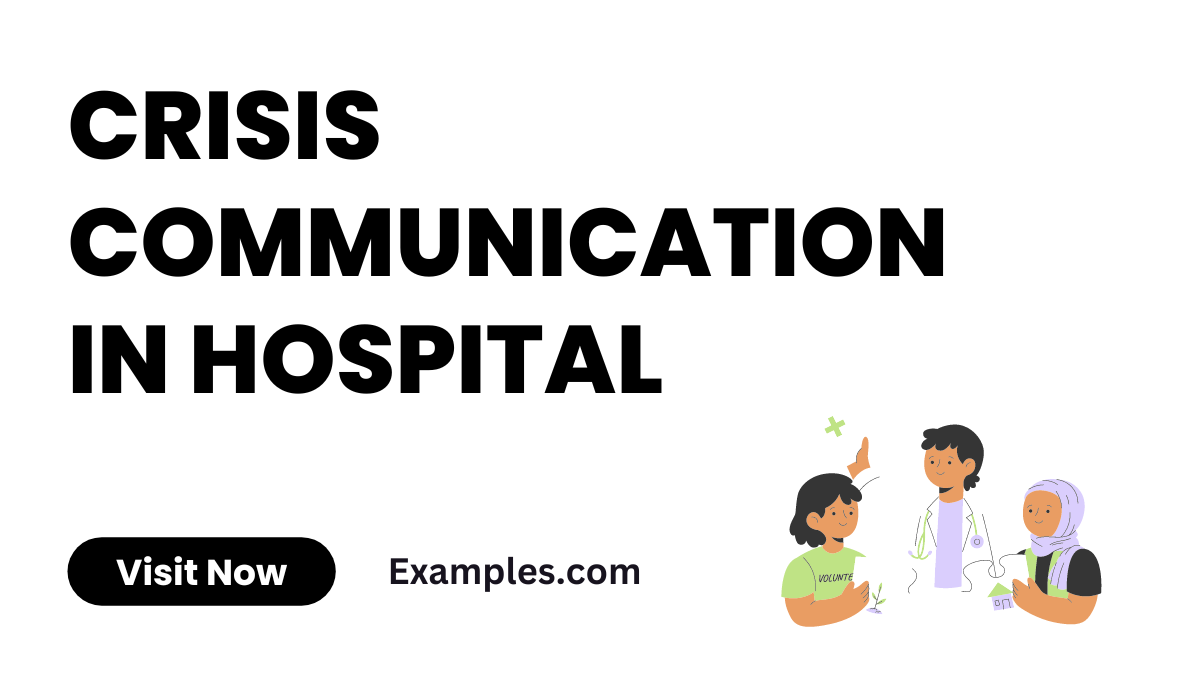19+ Crisis Communication in Hospital Examples
Embark on a comprehensive journey through Crisis Communication in Hospitals, exploring essential strategies, practical tips, and impactful Communication Examples. Learn how effective communication plays a pivotal role in navigating healthcare challenges and ensuring resilience in times of crisis. Elevate your crisis management skills with real-world insights and proven techniques tailored to the healthcare environment.
What is Crisis Communication in Hospital?

Crisis Communication in hospitals encompasses the strategic process of managing and disseminating information during unexpected events or challenges. In simple terms, it involves clear, timely communication to address uncertainties, ensuring stakeholders, including patients and staff, stay informed and confident in the face of unforeseen situations. This deliberate approach is critical for maintaining trust, stability, and effective healthcare delivery during crises.
What is the Best Example of Crisis Communication in Hospital?

One remarkable example of Crisis Communication in a hospital is the response to a sudden surge in patient cases during a public health crisis. The hospital promptly initiated transparent communication, providing regular updates on patient care, safety measures, and resource management. Collaborating with public health authorities, the hospital demonstrated transparency, empathy, and efficiency, showcasing the vital role of effective crisis communication in maintaining public trust and ensuring optimal patient outcomes.
20 Crisis Communication in Hospital Examples

These examples illustrate the diversity and importance of crisis communication in hospitals, emphasizing the need for adaptability and clear communication channels in every situation.
- Code Blue Activation: Immediate response to life-threatening situations, involving rapid deployment of medical teams.
- Mass Casualty Incident (MCI) Notification: Coordinating resources and personnel for a surge in patient volume.
- Infection Outbreak Communication: Transparent dissemination of information to prevent panic and guide preventive measures.
- Emergency Room Diversion: Notifying relevant stakeholders when ER resources are temporarily redirected due to overwhelming demand.
- Natural Disaster Preparedness: Communicating evacuation plans and safety measures ahead of anticipated disasters like hurricanes or earthquakes.
- Supply Chain Disruption Communication: Informing staff about alternative resources and procedures during shortages or delays in medical supplies.
- Staff Safety Protocols: Clear guidelines on protecting healthcare workers during infectious outbreaks, emphasizing PPE usage.
- Patient Evacuation Plan: Coordinating safe patient transfers during emergencies such as fires or structural issues.
- Public Health Alerts: Timely dissemination of information regarding contagious diseases to the broader community.
- Hospital Security Breach: Communicating lockdown procedures and ensuring staff awareness in case of a security threat.
- Technology Failure Response: Clear steps for staff to follow when faced with issues like electronic health record system failures.
- Communication with Families during Critical Care: Providing compassionate and regular updates to families during intensive care situations.
- Active Shooter Protocol: Rapid dissemination of information to staff, patients, and visitors, ensuring a secure response.
- Utility Outage Communication: Informing staff about backup systems and contingency plans during power or utility failures.
- Medical Error Disclosure: Transparent communication about errors, focusing on resolution and preventing recurrence.
- Patient elopement communication: Quick notification and search procedures for missing patients within the hospital premises.
- Legal and Ethical Dilemmas: Open dialogue on sensitive issues, involving legal counsel when needed.
- Internal Communication during Crisis: Ensuring seamless information flow within the hospital, promoting a cohesive response.
- Collaboration with Community Partners: Working with local authorities and organizations for a unified response in emergencies.
- Post-Crisis Debriefing: Facilitating open discussions among staff to learn from experiences and enhance future responses.
Crisis Communication in Hospital for Patients Examples
In times of medical emergencies, effective communication is pivotal for patients’ understanding and reassurance. Explore our carefully curated examples of crisis communication tailored for patients:
- Room Isolation Protocol Communication: Clearly informing patients about isolation measures to maintain safety during contagious outbreaks.
- Treatment Delay Notification: Providing compassionate notifications to patients about any delays in scheduled treatments, explaining the reasons succinctly.
- Visitor Restriction Announcements: Communicating visitor restrictions with empathy, highlighting the importance of safety for all.
- Medication Shortage Guidance: Offering guidance on alternative medications during shortages, ensuring continued patient well-being.
- Surgical Procedure Postponement Notice: Apologetically explaining and rescheduling elective surgeries due to unforeseen circumstances.
Crisis Communication in Hospital for Nurses Examples
Nurses play a crucial role in crisis situations; effective communication is paramount for their coordination and patient care. Explore examples tailored for nurses:
- Emergency Staff Deployment Instructions: Clearly instructing nurses on their roles and responsibilities during staff reallocation in crisis scenarios.
- Critical Equipment Failure Alert: Rapidly communicating alternative equipment solutions to nurses in the event of critical machinery failures.
- Personal Protective Equipment (PPE) Distribution Plan: Clearly outlining the plan for PPE distribution and guidelines for its proper usage during emergencies.
- Patient Triage Protocol Communication: Providing concise communication on patient triage procedures, ensuring efficient prioritization based on severity.
- Shift Rotation Changes Announcement: Notifying nurses about any changes in shift rotations due to emergency requirements, maintaining clear communication channels.
What is the Importance of Crisis Communication in Hospital?
In the high-stakes environment of healthcare, crisis communication is a linchpin for effective response and patient care. Clear and timely communication during emergencies is essential to ensure the well-being of patients, staff, and the community. Here’s why crisis communication in hospitals is of paramount importance:
- Patient Reassurance: Transparent communication instills confidence in patients, alleviating anxiety and ensuring they feel informed and cared for during crises.
- Staff Coordination: Effective communication fosters seamless coordination among healthcare professionals, ensuring a unified and efficient response to emergencies.
- Public Trust and Perception: Timely and honest communication builds trust with the community, enhancing the hospital’s reputation and fostering positive public perception.
- Risk Mitigation: Clear communication helps mitigate risks by ensuring that everyone involved understands their roles and responsibilities, reducing the likelihood of errors.
- Regulatory Compliance: Compliance with regulatory standards often hinges on effective communication, ensuring that the hospital meets legal obligations during crises.
- Resource Optimization: Efficient communication allows for the optimal allocation of resources, preventing bottlenecks and ensuring that critical services are prioritized.
- Community Safety: Hospitals are integral parts of communities, and effective crisis communication contributes to the overall safety and well-being of the surrounding population.
- Reduced Misinformation: Transparent communication from official channels minimizes the spread of misinformation, preventing panic and confusion among patients and the public.
How to improve the Crisis Communication in Hospital?
Enhancing crisis communication in hospitals requires a strategic and proactive approach. Here are actionable steps to improve communication during emergencies:
- Establish a Crisis Communication Team: Form a dedicated team with representatives from various departments to ensure comprehensive and coordinated communication efforts.
- Develop a Crisis Communication Plan: Create a detailed plan outlining communication protocols, responsibilities, and escalation procedures to streamline responses during crises.
- Training and Drills: Regularly conduct training sessions and drills to familiarize staff with crisis communication protocols, ensuring a swift and well-coordinated response.
- Utilize Multiple Communication Channels: Diversify communication channels, including digital platforms, intercom systems, and traditional media, to reach different audiences effectively.
- Preparedness Materials for Patients: Develop easily understandable materials for patients, outlining emergency procedures, evacuation plans, and how to access information during crises.
- Real-time Updates: Implement systems for real-time updates, ensuring that all stakeholders, including staff, patients, and the community, receive timely and accurate information.
- Feedback Mechanism: Establish a feedback mechanism to evaluate the effectiveness of communication strategies and identify areas for improvement.
- Crisis Communication Training for Staff: Provide ongoing training for healthcare professionals on effective communication strategies during high-stress situations.
Tips for Effective Crisis Communication in Hospital?
Effectively managing crisis communication in hospitals is vital for ensuring patient safety and staff coordination. Here are concise tips to enhance crisis communication:
1. Clear Protocols: Establish defined roles, a structured chain of command, and standardized tools for seamless internal communication.
2. Regular Training: Train staff on crisis protocols through drills, simulations, and communication skills sessions for improved readiness.
3. Patient-Centric Strategies: Develop crisis communication materials tailored for patients, ensuring clarity, simplicity, and accessibility.
4. Utilize Technology: Implement mass notification systems, telehealth platforms, and social media for swift and widespread information dissemination.
5. Transparency Matters: Prioritize open and transparent communication, providing regular updates to both staff and patients to build trust.
6. External Coordination: Establish communication channels with external partners, collaborate with community resources, and ensure a unified response.
In conclusion, effective crisis communication in hospitals is a cornerstone for ensuring patient safety, staff coordination, and community trust. The comprehensive guide and examples provided serve as valuable resources for implementing proactive communication strategies during emergencies. By prioritizing transparency, training, and collaboration, hospitals can navigate crises with resilience, fostering a sense of security and confidence within their communities.



